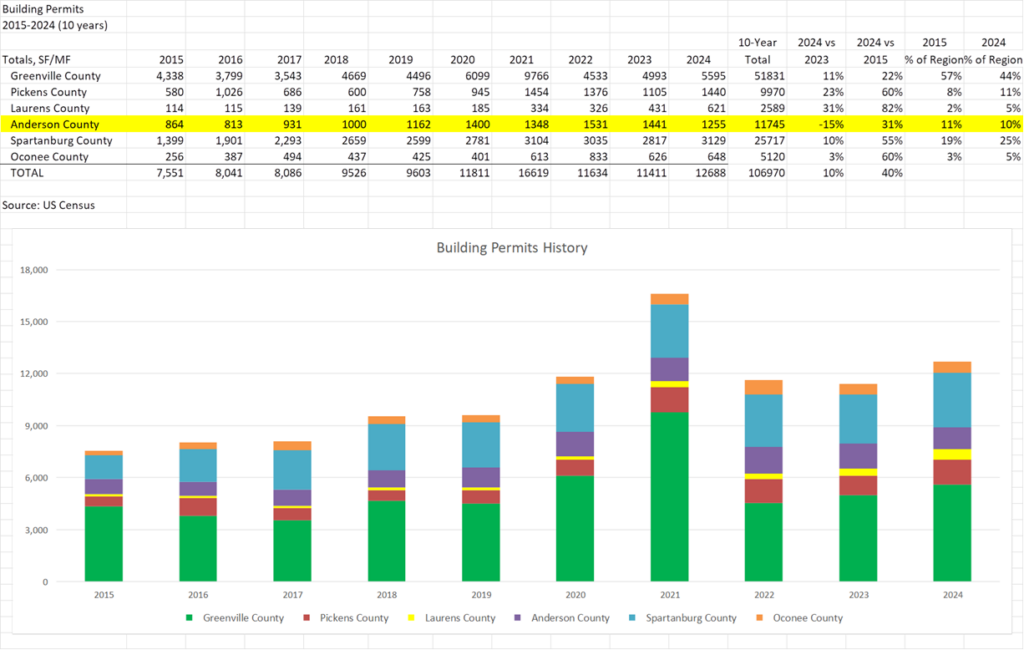Hello REALTORS®,
Last week I reported on the proposed moratorium on new subdivisions of 25 lots or more in Anderson County. In addition to subdivisions, Anderson County Council amended the proposed ordinance to apply to town homes and apartments. They also amended it to require each council member to opt in their council district. They approved the moratorium for the first time on February 18 and are expected to vote on it for the second time on March 4.
State law requires county councils to “read” and vote on a proposed ordinance three times before it becomes law. Cities are only required to vote on ordinances twice.
Your Western Upstate Association of REALTORS® opposes moratoriums. You can see the association’s policy paper on moratoriums by clicking here.
Moratoriums have become increasingly popular, and often demanded by citizens who see them as a means of stopping new development, especially new housing. Pickens County, Clemson, and Pendleton have each imposed moratoriums in the last five years, sometimes lasting a year or more. The City of Easley has a moratorium in place for nine months.
On behalf of the association, below is the letter I wrote to Anderson County Council informing them of our opposition to their proposed moratorium.
Chairman Dunn and Anderson County Councilmembers,
On behalf of the nearly 2,000 members of the Western Upstate Association of REALTORS®, I would like to share with you our position on the proposed moratorium. Attached is our official policy position on moratoriums. In short, we opposed moratoriums for two primary reasons:
- We believe they deny property owners the right to petition their government for a permit that is required by law and ordinance.
- We also believe, as others have said, that a moratorium demonstrates a failure to plan.
There has been a lot of discussion about the growth in Anderson County, particularly in our schools. We gather data on the Upstate including population, student population, and building permits. I am sharing some of that data with you here.
Below is data we collected on student population in the county.

Overall, student growth isn’t nearly as robust as has been stated. In fact, in much of the county, student population is shrinking and the overall student population in the county barely increased over the last 10 years.
The fastest growing school district is Anderson 1. But they are not growing dramatically fast—about 1% a year, which is twice as fast as US population growth, but half as fast as the regional population growth and the same as Anderson County’s population growth. And that is just Anderson 1. Overall, Anderson County student population grew by just 200 students during the last 10 years.
On average, in Anderson County, it takes about 60 new housing units to produce 1 student. And any assumptions we make about Anderson 1 suggests that their new house to new student ratio is about 8-10 houses per student, well below what school district officials have claimed.
We also collect population data, which is below.

Like schools, Anderson County’s population is growing more quickly than the US population, but slower than the average growth rate in the Upstate. And the rate of growth is slowing as you can see in the data above. None-the-less, our population has increased by 50,000 people since 2000, and about 35,000 since 2015. Those new residents need a place to live. Below is data we gather from the US Census on building permits, a good measure of housing production. Note that we combine single-family and multi-family permits.

During the last 10 years, Anderson County permitted about 12,000 housing units to accommodate growth of about 35,000 people. Based on that population growth, using 2.5 people per housing unit, the county needed to permit about 14,000 housing units. That helps explain our county’s affordable housing problem, and a moratorium will only make it worse.
A significant part of the county’s problem is that growth is concentrated in one area of the county—Powdersville and the Anderson 1 school district. A person might argue that a moratorium will help that area. However, overall, the Anderson County is not growing overly fast. In fact, the county is growing slower than the regional average. And it is under-producing housing. We believe a moratorium will hurt all of Anderson County, even Powdersville. But even if you think a moratorium will help that area, it will hurt the rest of the county.
We think our position on a moratorium is not only the correct one, but supported by the data which suggests that the county needs more housing, not less.
Michael Dey, Director of Government Affairs
Western Upstate Association of REALTORS®



